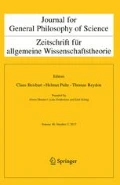Abstract
This paper is concerned with connections between scientific and metaphysical realism. It is not difficult to show that scientific realism, as expounded by Psillos (1999) clearly qualifies as a kind of metaphysical realism in the sense of Putnam (1980). The statement of scientific realism therefore must not only deal with underdetermination and the dynamics of scientific theories but also answer the semantic challenges to metaphysical realism. As will be argued, the common core of these challenges is the proposition that a (metaphysical) realist semantics leads to semantic agnosticism in the sense that we are unable to grasp the proper meanings and referents of our linguistic expressions. Having established this, I will focus more specifically on the question of whether scientific realism—in its state-of-the-art account—has the resources to make reference to scientific concepts intelligible such that the semantic challenges can be answered.
Similar content being viewed by others
Notes
Davidsonian truth-conditional semantics diverges slightly from (model-theoretic) interpretational semantics in that truth is taken as the basic undefined concept, with the intention to explicate meaning on the basis of the use of the language (Davidson 1984). Hence, in this semantics, truth is not understood as truth under the intended interpretation. Putnam’s model-theoretic argument, therefore, will not apply directly. It is doubtful, however, whether Davidsonian truth-conditional semantics accords coherently with the realist distinction between truth makers of statements, i.e., truth-conditions that obtain, and statements themselves. Once such a distinction is made, truth does not seem to figure as a primitive notion any more. It is easy to see, moreover, that Dummett’s manifestation and acquisition challenge are an issue for Davidsonian truth-conditional semantics.
Operational constraints are also characterised as comprising all measurements of scientific magnitudes. They may even imply information about the outcome of counterfactual measurements.
Dummett himself also advocates the principle of compositionality but under an intuitionistic reading of the logical constants.
It would have been more precise to say that the value of t cannot even partially be determined without accepting some application of T to an empirical system as being successful without any justification, where such an application implies the statement that some axiom of T holds true for this system. But to fully appreciate the content of this formulation, it would have been necessary to give a more fine-grained exposition of the manner in which Sneed employs techniques of the semantic approach to scientific theories. The above formulation presents the core of the problem of theoretical terms.
As for the semantics of non-theoretical concepts and sentences, it is advisable to adopt a verificationist account of meaning in order to block the model-theoretic argument by Putnam.
References
Andreas, H. (2010). A modal view of the semantics of theoretical sentences. Synthese, 174(3), 367–383.
Bohnert, H. G. (1968). In defense of Ramsey’s elimination method. The Journal of Philosophy, 65, 275–281.
Carnap, R. (1973). Introduction to symbolic logic and its applications. New York: Dover Publications.
Cruse, P. (2005). Scientific realism, Ramsey sentences and the reference of theoretical terms. Studies in History and Philosophy of Science, 36(3), 557–576.
Davidson, D. (1984). Enquiries into truth and interpretation. Oxford: Oxford University Press.
Dummett, M. (1978). Truth and other enigmas. London: Duckworth.
Dummett, M. (1991). The logical basis of metaphysics. Cambridge, Mass: Harvard University Press.
Etchemendy, J. (1999). The concept of logical consequence. Stanford: CSLI Publications.
Frege, G. (1892). Über Sinn und Bedeutung. Zeitschrift für Philosophie und philosophische Kritik, 100.
Frege, G. (1918/19). Der Gedanke. Beiträge zur Philosophie des deutschen Idealismus, 2, 58–77.
Hale, B., & Wright. C. (1997). Putnam’s model-theoretic argument against metaphysical realism. In: B. Hale & C. Wright (Eds.), A companion to the philosophy of language. Oxford: Blackwell.
Ketland, J. (2004). Empirical adequacy and ramsification. British Journal for Philosophy of Science, 55, 287–300.
Lewis, D. (1970). How to define theoretical terms. Journal of Philosophy, 67, 427–446.
Lewis, D. (1984). Putnam’s paradox. Australasian Journal of Philosophy, 62(3), 221–236.
Psillos, S. (1999). Scientific realism. London: Routledge.
Putnam, H. (1980). Models and reality. Journal of Symbolic Logic, 45(3), 464–482.
Putnam, H. (1981). Reason, truth and history. Cambridge: Cambridge University Press.
Ramsey, F. P. (1950). Theories. In: R. B. Braithwaite (Ed.), The foundations of mathematics and other logical essays (pp. 212–236). New York: Humanities Press.
Russell, B. (1905). On denoting. Mind, 14, 479–493.
Schurz, G. (2005). Semantic holism and (non-)compositionality of scientific theories. In: M. Werning, E. Machery, & G. Schurz (Eds.), The compositionality of meaning and content (Vol. I, pp. 271–284). Frankfurt: Ontos-Verlag.
Sneed, J. (1979). The logical structure of mathematical physics, 2nd ed. Dordrecht: D. Reidel Publishing Company.
Wright, C. (1993). Realism, meaning and truth, 2nd ed. Oxford: Blackwell.
Acknowledgments
I am grateful to an unknown reviewer for very helpful comments on a first draft of this paper.
Author information
Authors and Affiliations
Corresponding author
Rights and permissions
About this article
Cite this article
Andreas, H. Semantic Challenges to Scientific Realism. J Gen Philos Sci 42, 17–31 (2011). https://doi.org/10.1007/s10838-011-9153-1
Published:
Issue Date:
DOI: https://doi.org/10.1007/s10838-011-9153-1


